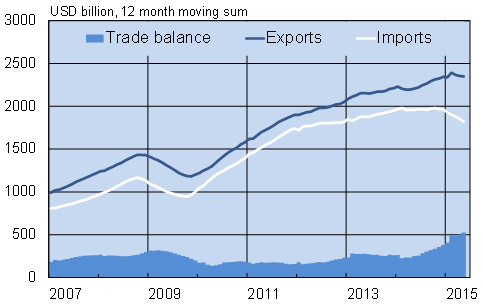BOFIT Weekly Review 24/2015
China’s exports and imports continue to shrink
China’s foreign trade statistics show that the value of exports compared to a year earlier contracted by 2 % in May, while the value of imports was down 18 %. The May trade surplus again approached the all-time monthly record of $60 billion. In the three-month March-May period, the value of exports declined 8 % and the value of imports was down 16 % from March-May 2014.
The sharp drop in the value of imports reflects falling global prices for energy and other commodities, but also lower import volumes, which in recent months have been running slightly below levels a year earlier. However, the volume of crude oil imported to China in March-May was up 4 % from the same time in 2014. Also export prices have been on a mild downward trend and export volumes have remained lower than a year earlier.
The decline in import volumes reinforces the wider view of a slowing Chinese economy. Export trends have been affected by growth in export markets and shifting foreign exchange rates. While the yuan-dollar exchange rate was relatively stable since last year, the yuan has appreciated against most of the currencies of its other main trading partners. This shift partly explains why China’s exports to the US in recent months have continued to rise, while exports to the Eurozone and Japan have declined 10–15 %.
A notable trend is the significant decline in China’s processing trade as a share of total goods exports. At the start of this decade, the processing and assembly activities in international production chains accounted for over 50 % of the total value of goods exports in China’s foreign trade figures. Since then, the share of processing trade has gradually declined, and was about 40 % in January-May of this year. At the same time, the structure of imports has not undergone a similar shift. Imports reported as processing trade have held steady at around 30 %.
China’s foreign trade, USD billion

Source: Bloomberg